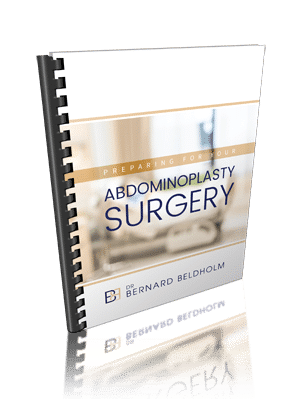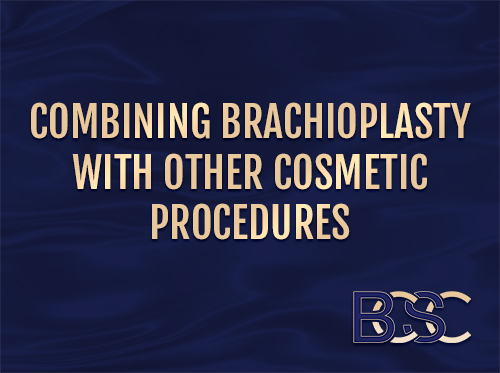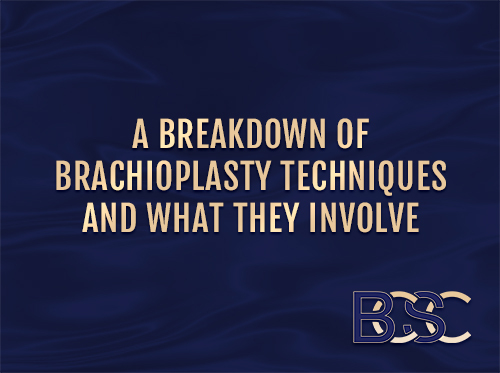Traditional Abdominoplasty vs. Fleur-de-lis Abdominoplasty
Both the fleur-de-lis and traditional abdominoplasty procedures are designed to treat excess skin, and they share some significant similarities. However, there are key differences between them. The fleur-de-lis abdominoplasty is a more extensive abdominoplasty procedure that treats loose skin both horizontally and vertically. In contrast, traditional abdominoplasty surgery primarily focuses on vertical loose skin only.
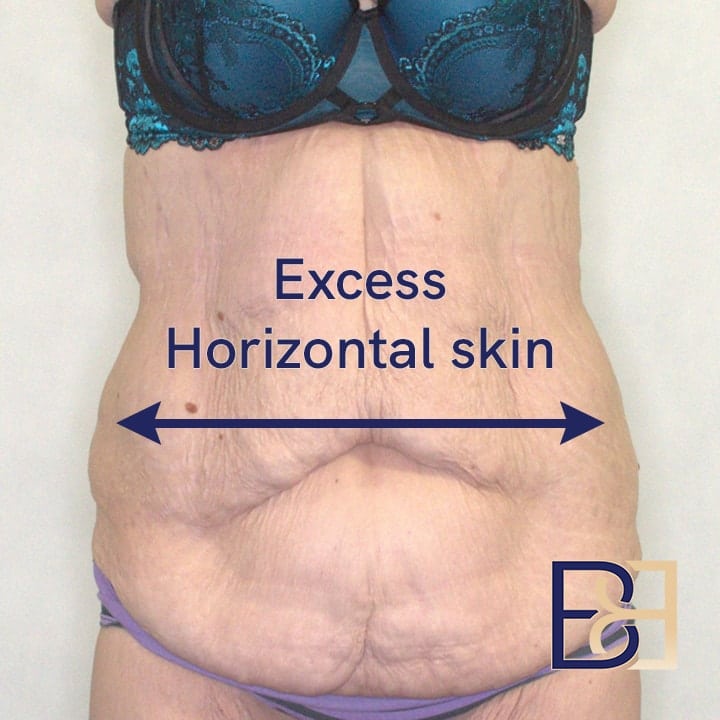
- Excess Horizontal skin | BCSC
Patients considering abdominoplasty (tummy tuck) may have challenges choosing the right procedure that meets their goals. Both traditional abdominoplasty and fleur-de-lis abdominoplasty treat excess abdominal skin and fatty tissue. They share numerous similarities but still have several differences that distinguish them apart, especially when it comes to the suitability of different patients.
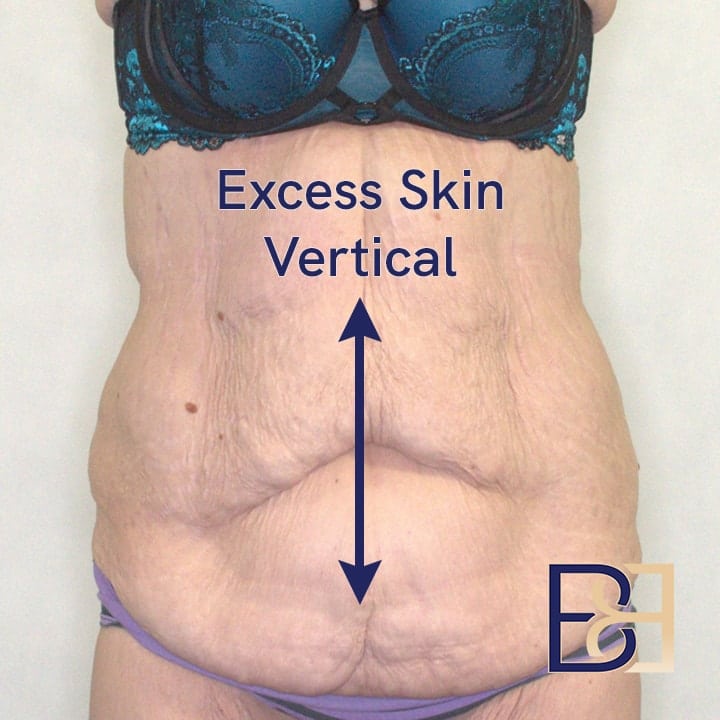
- Excess vertical skin | BCSC
Today, we’ll compare and contrast traditional abdominoplasty vs. FDL to help potential patients make informed decisions.
Summary of the Key Differences between Traditional Abdominoplasty and Fleur-de-lis Abdominoplasty
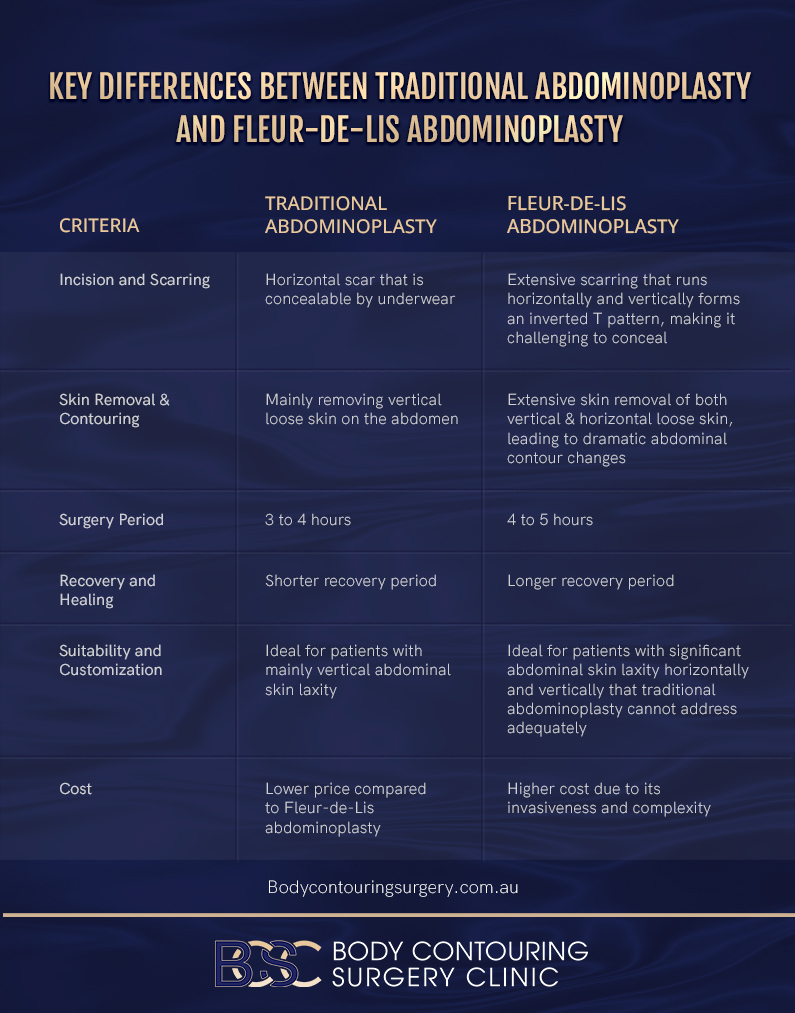
- Table of the key differences between Standard Abdominoplasty vs Fleur de lis abdominoplasty
Understanding Traditional Abdominoplasty
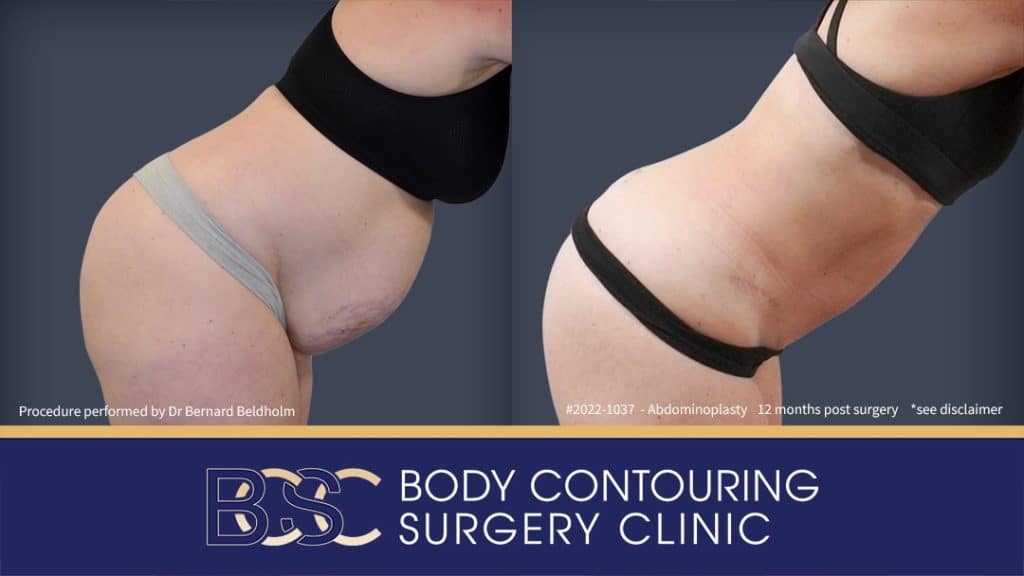
- Extended abdominoplasty | Operation performed by Dr Bernard Beldholm
Disclaimer: Operation performed by Dr Bernard Beldholm. Adult content, surgery has risks; individual results vary, seek 2nd opinion. Please see the full disclaimer.
A scientific study published by PubMed notes, “[t]he abdominoplasty, commonly referred to as a “tummy tuck,” is a procedure to reduce the excess skin and fat around the abdomen and strengthen the abdominal wall musculature. The goal of this procedure is to develop an aesthetically pleasing abdomen.”
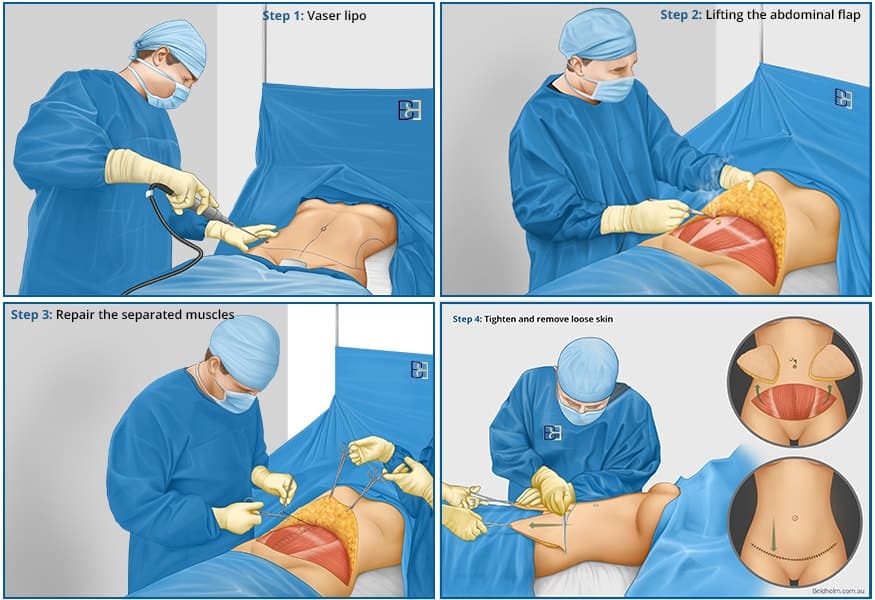
- Dr Beldholm abdominoplasty operation steps | BCSC
Procedure Details
Traditional abdominoplasty involves a horizontal hip-to-hip incision along the patient’s waistline, just above the pubic region, making it easily hidden by underwear or bikini bottoms. The incision is similar to that of a C-section. It is important to note that the extent of lax skin and fatty tissue will determine the incision length. This means that the incision size will vary from one patient to another.
Though traditional abdominoplasty can be performed with or without liposuction, Dr. Beldholm incorporates VASER liposuction into his abdominoplasty procedures for results, when necessary. VASER liposuction is a specialised liposuction technique that treats excess fat that cannot be treated effectively by a standard abdominoplasty alone. VASER liposuction uses ultrasound waves to break down fat cells, making them easier to remove. It also minimises damage to the surrounding tissue, reducing recovery time, and delivering smoother results than traditional liposuction.
After the Procedure
Our recommendation for abdominoplasty patients is to spend from two to three days in the hospital, depending on the scope of the surgery.
While it may be medically reasoable for patients to return home (with a driver) after the abdominoplasty on day one, moving from place to place after a cosmetic surgery is sure to be unpleasant. Most abdominoplasty patients find that the immediate aftermath of the surgery is the most challenging period to endure. To make these first few days more bearable, stay a few extra days before going home.
After the procedure, patients should take time off work for a smooth recovery. Though most patients can resume light activities and sedimentary jobs 2 to 4 weeks post-surgery, it’s important to avoid lifting heavy items, strenuous activities, and rigorous exercise as these actions could delay healing. Patients should wear the compression garment and strictly follow all of the surgeon’s instructions.
It will take about 2-3 months before the patient can start enjoying the procedures’ results and begin to feel normal again. Full recovery, however, will take longer, with residual swelling and scar healing taking around 6 to 12 months.
Ideal Candidate for Traditional abdominoplasty
Traditional abdominoplasty is ideal for patients with minimal to moderate loose skin and separated abdominal muscles (diastasis recti) in the abdomen. These include post-pregnancy women and weight loss patients. The general surgeon will carry out a physical assessment and target skin and fatty tissue in the front abdomen. Ideal patients must also have maintained a stable weight.
Benefits
- Abdominal shape: Traditional abdominoplasty removes excess skin on the abdominal region, tightening the abdomen.
- Repairing abdomen muscles: Since most patients with excess abdominal skin experience weak or separated abdominal muscles (diastasis recti), traditional abdominoplasty helps correct this by repairing the muscles and tightening the core.
- Patient’s posture: Removal of the excess abdominal fat may improve the patient’s posture.
- Bladder function: loose abdominal skin and diastasis recti are associated with bladder complications, which may improve after abdominoplasty surgery.
- Back pain issues: After significant weight loss or giving birth, most women complain of back pain that result from weakened abdominal muscles. Abdominoplasty tightens the weakened muscles, resulting in much-needed abdominal support that can extensively alleviate back pain.
- Cost: Traditional abdominoplasty generally offers a more affordable option compared to the Fleur-de-lis technique, which is more complex and invasive.
Limitations
- Limited skin removal: Traditional abdominoplasty remove minimal to moderate abdominal skin as compared to extensive abdominoplasty surgeries like FDL abdominoplasty.
- Scarring: Surgical procedures poses a risk of scarring. Even though normal, there are instances of poor scarring, where the scar tissue becomes conspicuous and hard to cover. These hypertrophic scars might call for additional attention from the patient.
Understanding Fleur-de-lis Abdominoplasty
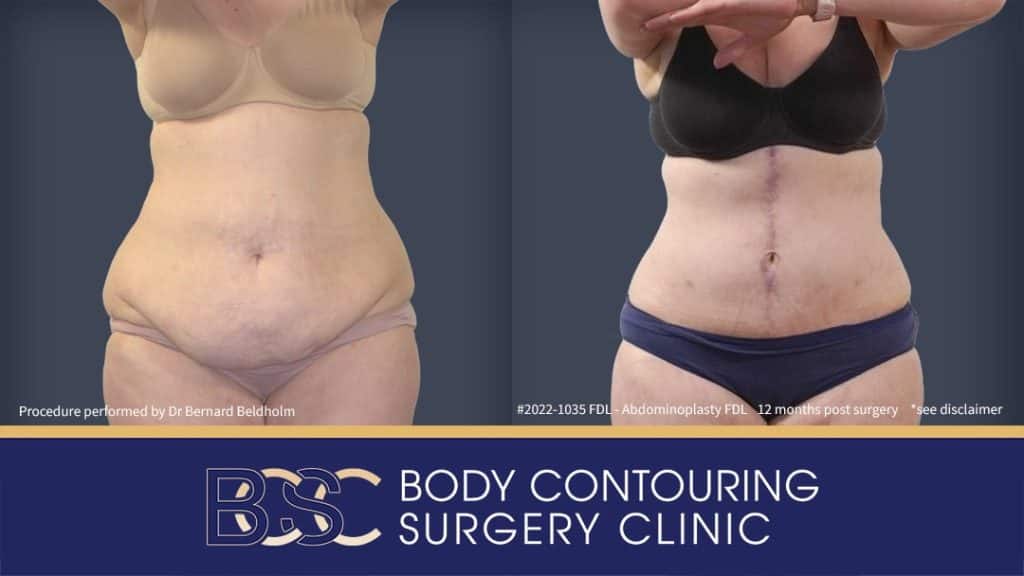
- Upper abdomen excess skin
Disclaimer: Operation performed by Dr Bernard Beldholm. Adult content, surgery has risks; individual results vary, seek 2nd opinion. Please see the full disclaimer.
Also referred to as vertical abdominoplasty or corset lipectomy, Fleur-de-lis abdominoplasty is a special variant of abdominoplasty that is particularly suited to patients with massive skin laxity that would be hard to deal with using traditional abdominoplasty.
The name, fleur-de-lis, is derived from the procedure’s incision pattern, which resembles a partially closed Irish flower.

- Water lilly – Fleur de lis | BCSC
The FDL abdominoplasty procedure is more invasive than traditional abdominoplasty, loose abdominal skin both horizontally and vertically, making it ideal for massive weight loss patients.
A Fleur-de-lis research study explains, “Vertical abdominoplasty is an effective procedure to correct abdominal contour abnormalities in individuals with excessive soft tissue in both the vertical and transverse orientation.”
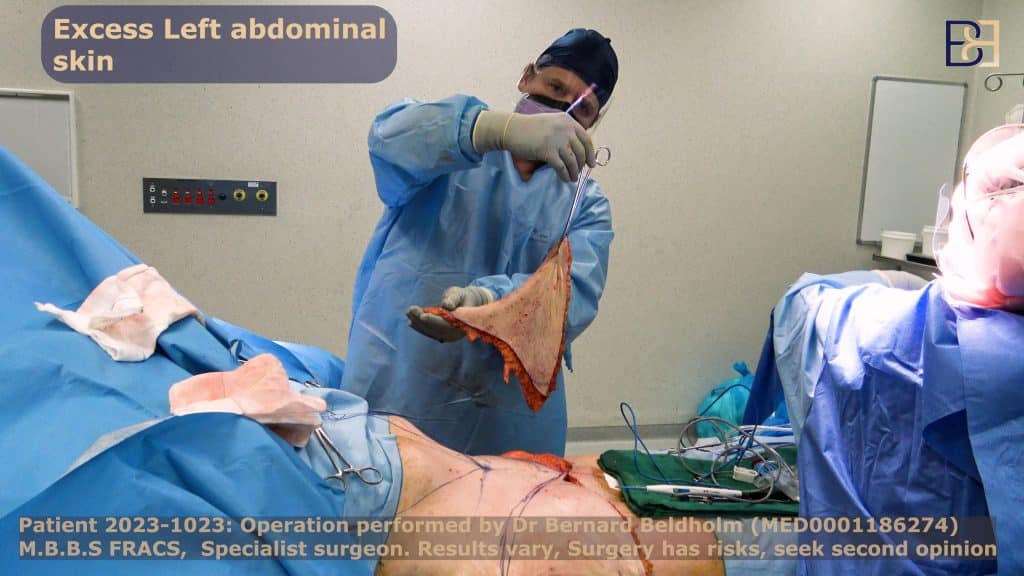
Procedure Details
Fleur-de-lis abdominoplasty is a more extensive procedure than traditional abdominoplasty procedures. The horizontal incision is a hip-to-hip incision running along the waistline, while the additional vertical incision connects with horizontal incision at the groin region and runs upwards along the midline to a few inches below the ribs. The two Fleur-de-lis incisions form an inverted “T” pattern when closed.
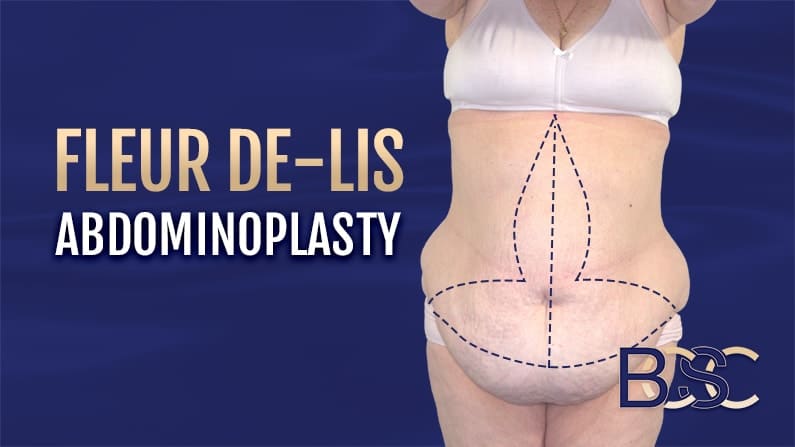
- Fleur de lis abdominoplasty excision pattern | BCSC
The recovery time for FDL abdominoplasty, which will be longer than traditional abdominoplasty due to the procedure’s invasiveness, will vary from one patient to another. Generally, Fleur-de-lis abdominoplasty involves a 3 to 4 day hospital stay.
To manage severe pain, your specialist surgeon will prescribe pain medication for approximately 2 weeks, which should be taken as directed to help in pain management. Patients can resume driving 10-14 days after surgery once the use of pain meds have ceased and may return to sedentary jobs (e.g. office, desk work) after approximately 2 weeks.
Ideal Candidate for Fleur-de-lis Abdominoplasty
FDL abdominoplasty is ideal for patients with significant loose abdominal skin extending both horizontally and vertically. These include massive weight loss patients following bariatric surgery and postpartum women.
A study published by National Library of Medicine notes “[i]deal candidates are patients with upper abdominal skin laxity who may not achieve an adequate aesthetic result with transverse-only excision.”
Benefits
- Removes significant loose skin: Fleur-de-Lis abdominoplasty removes excess loose abdominal skin that traditional abdominoplasty procedures cannot treat adequately. This makes the procedure effective for substantial weight loss patients with significant loose skin and excess fatty tissue.
- Vertical skin laxity: While traditional abdominoplasty treats only horizontal skin laxity, FDL abdominoplasty targets both horizontal and vertical skin laxity.
- Abdominal contour: The extensive skin removal gives the abdominal contour a upgraded appearance.
- Tightens the core: Fleur-de-Lis abdominoplasty allows the specialist surgeon to repair and tighten both lower and upper abdominal area muscles, which helps tighten the core.
- Treats urinary incontinence: Many massive weight loss patients experience urinary complications due to excess pressure exerted on the bladder.
- Overall body functionality: Excess sagging belly skin may impede body functionality, which impacts an individual’s daily activities, including anything from exercise, heavy lifting and primary care for children.
- General health concerns: Some common potential complications ** by Fleur-de-Lis include skin chafing and wound infection.
Limitations of Fleur-de-lis Abdominoplasty
- Abdominal Scarring: FDL abdominoplasty leaves a long “anchor” or “inverted T” shaped scar that is difficult to completely hide with clothing, bikinis, or undergarments.
- Surgery Time: Fleur-de-lis surgery is extensive and often takes approximately 1 to 2 hours longer than the traditional abdominoplasty.
- Cost: Fleur-de-lis abdominoplasty is more expensive compared to other procedures due to its complicated nature as well as the length of time in the operating room.
Comparing the Two Procedures
Though Fleur-de-Lis abdominoplasty is similar in many ways to a traditional abdominoplasty, the medical procedures have some significant differences, including the following:
Cost
The cost of traditional abdominoplasty is typically lower compared to Fleur-de-Lis abdominoplasty due to differences in surgical complexity. Traditional abdominoplasty focuses on the lower abdomen, while Fleur-de-Lis abdominoplasty include both the upper and lower abdominal areas, requiring a more intricate approach and longer surgery.
This increased complexity, along with the need for a potentially longer surgery time, hospital stay, and recovery period, generally results in higher costs for Fleur-de-lis abdominoplasty.
Incision and Scarring
Traditional abdominoplasty is characterised by a horizontal incision running just above the pubic region along the waistline, while Fleur-de-Lis abdominoplasty requires two incisions, one running horizontally, similar to a traditional abdominoplasty incision, and the other running vertically along the midline.
Excess Skin Removal and Contouring
Traditional abdominoplasty removes minimum to moderate loose skin and repairs the horizontal muscles of the abdomen. Consequently, it is suitable for patients with minimum-to-moderate horizontal laxity of the skin.
By contrast, Fleur-de-Lis abdominoplasty removes significant loose abdominal skin and repairs abdominal muscles both horizontally and vertically. Considering that, Fleur-de-Lis abdominoplasty is ideal for patients with horizontal and vertical massive loose abdominal skin laxity. Skin removal through Fleur-de-Lis abdominoplasty results in dramatic changes to the contour of the abdomen that is easily noticed.
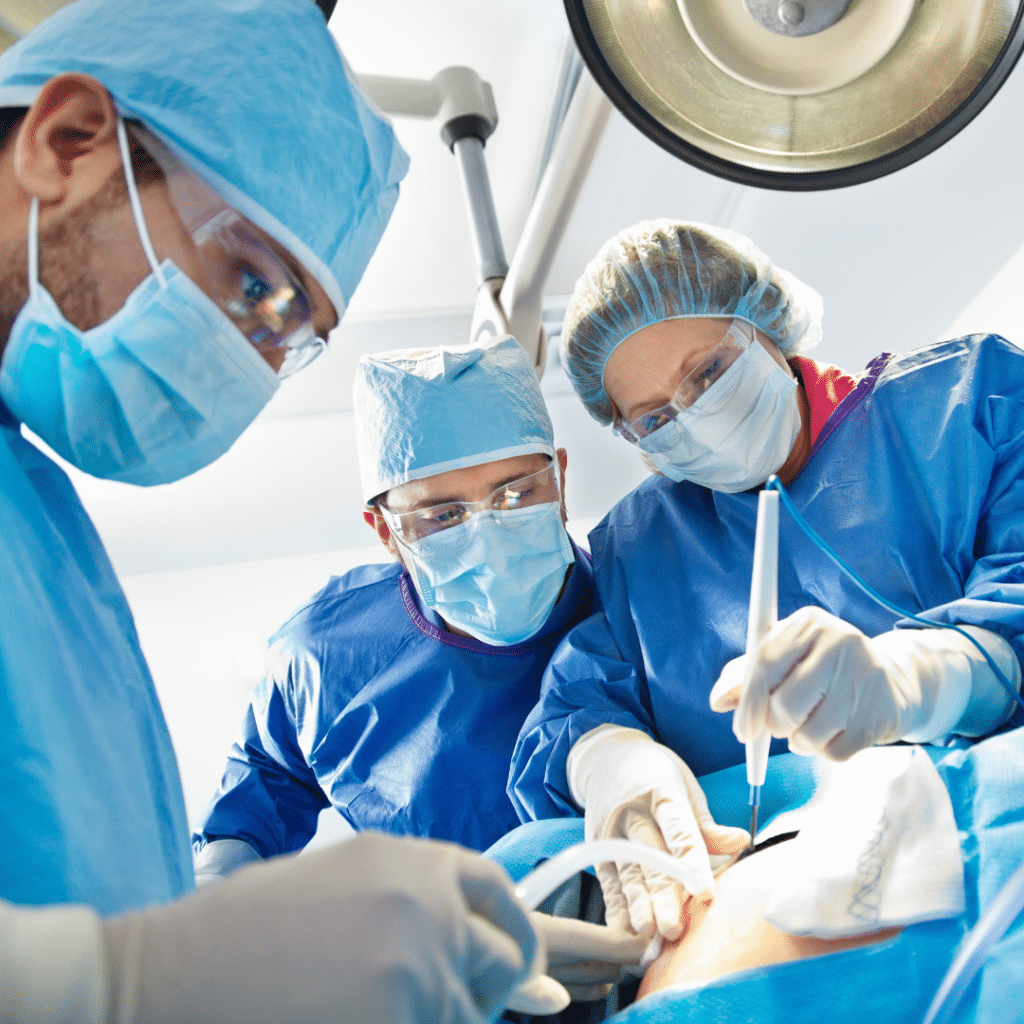
Time in the Operating Room
Standard abdominoplasty surgery generally takes about 3 to 4 hours, while Fleur-de-Lis abdominoplasty takes approximately 4 to 5 hours because of the extensiveness and complexity of the nature of the operation. Consequently, Fleur-de-Lis patients spend more time in the operating room.
Hospital Stay
After a standard abdominoplasty, patients can typically go home within 1 to 3 days, provided there are no adverse effects or complications. In contrast, patients who undergo a Fleur-de-Lis abdominoplasty are usually required to stay in the hospital for 2 to 4 days for monitoring. Additionally, due to the larger incision associated with the Fleur-de-Lis procedure, these patients are likely to experience more post-surgical pain once the anesthesia wears off.
Recovery and Healing
The recovery timeline of Fleur-de-Lis abdominoplasty is also longer compared to that of standard abdominoplasty. Most patients undergoing traditional abdominoplasty are able to resume light work after 2 to 3 weeks, while Fleur-de-Lis patients take approximately 4 weeks before they can return to work. Though Fleur-de-Lis abdominoplasty surgery has higher risks of possible complications than traditional abdominoplasty, most can be prevented by adhering to post-operative instructions.
Suitability and Customisation
As noted above, each of the surgical procedures will suit a different category of patients. In arriving at suitability for each of the procedures, the specialist surgeon identifies the amount of loose skin that is to be removed. However, the goals of the patient will become a key determinant of the amount of skin that is to be removed. The other factors to be considered will include body type, medical history, and skin condition of the patient.
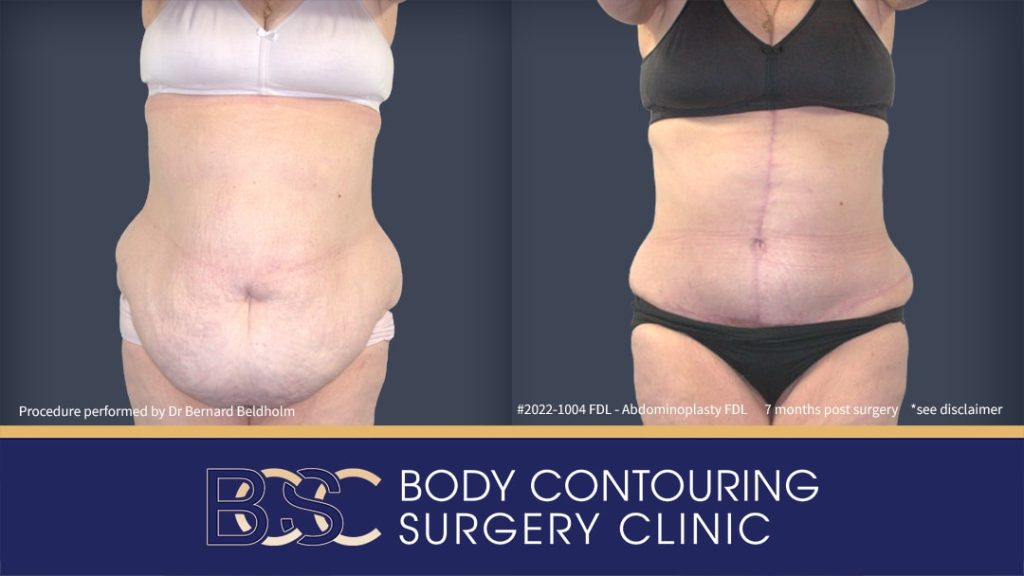
- Fleur de lis abdominoplasty by Dr Bernard Beldholm | BCSC
Disclaimer: Operation performed by Dr Bernard Beldholm. Adult content, surgery has risks; individual results vary, seek 2nd opinion. Please see the full disclaimer.
Patient Considerations
Now let’s take a look at some of the major considerations one needs to understand before choosing which surgery to undergo.
Consultation with a Surgeon
Before making a decision, one should consult with an experienced FRACS surgeon such as Dr Beldholm. During the consultation, it is important to ask the surgeon the following questions.
- Are you a FRACS specialist surgeon?
- Are you experienced in abdominoplasty surgery?
- Which procedure do I qualify for?
- Do you have before and after photos of previous clients?
- How long will my recovery take?
- What are your counteractive techniques for minimising complications?
- What can I expect at the end of the procedure?
Additionally, it is important for patients to provide their medical history and any cases of allergic reactions to the specialist surgeon to aid in making certain decisions regarding anaesthesia and other protocols.
Understanding Expectations and Outcomes
One key, yet most neglected, factor when making decisions is setting realistic goals. The goals will aid in deducing your suitability for a particular procedure. For example, patients who desire minimal abdominal contour changes are generally more suited for traditional abdominoplasty, while patients that require dramatic abdominal contour changes call for Fleur-de-Lis abdominoplasty.
Regardless of the procedure, the patient should have realistic goals and remember that any form of surgery can lead to unanticipated complications or less-than-perfect outcomes.
Long-term Results and Maintenance
It is worth mentioning that although abdominoplasty results are permanent, one must follow post-operative protocols to maintain the results. This includes weight management that incorporates healthy eating habits and regular exercise, and avoids yo-yo eating.
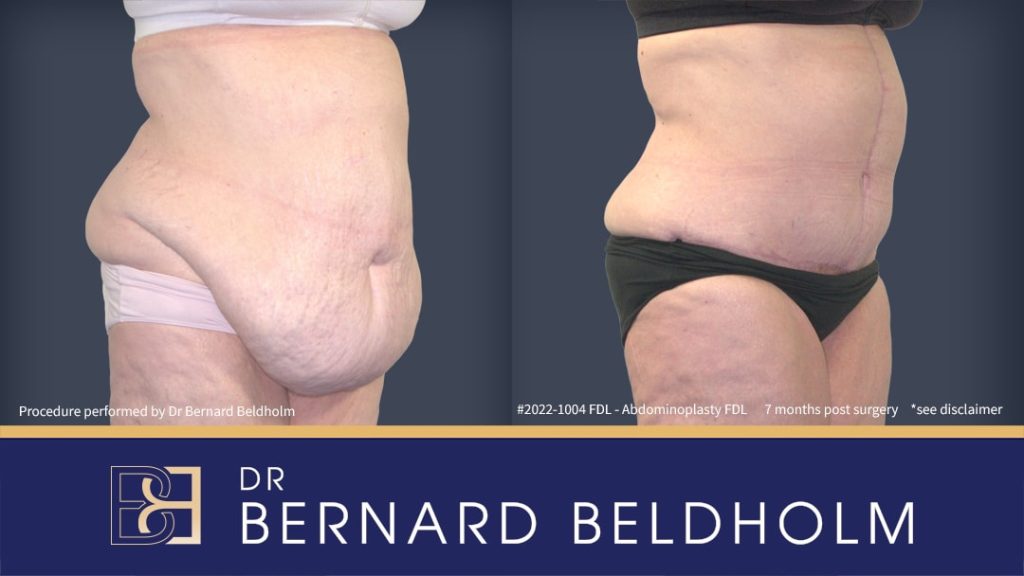
- Fleur de lis abdominoplasty by Dr Beldholm | BCSC
Disclaimer: Operation performed by Dr Bernard Beldholm. Adult content, surgery has risks; individual results vary, seek 2nd opinion. Please see the full disclaimer.
Dr. Beldholm’s Final Thoughts

- Dr Bernard Beldholm
Both Fleur-de-Lis abdominoplasty and traditional abdominoplasty remove loose skin on the abdomen after significant weight loss, but there are some important differences between these two procedures as mentioned above.
While a patient may have an idea as to which surgery would best suit their needs and goals, it’s important to consult a specialist surgeon to determine which procedure fits into a set of criteria.
Book a consultation today with Body Contouring and Surgery Clinic for a personalised consultation and advice.
Resources
- Regan, J. P., & Casaubon, J. T. (2023). Abdominoplasty. In StatPearls. StatPearls Publishing.
- Hafezi, F., & Nouhi, A. (2006). Safe abdominoplasty with extensive liposuctioning. Annals of plastic surgery, 57(2), 149–153.
- Regan JP, Casaubon JT. Abdominoplasty. [Updated 2023 Jul 24]. In: StatPearls [Internet]. Treasure Island (FL): StatPearls Publishing; 2024 Jan-.
- Mitchell, R. T., & Rubin, J. P. (2014). The Fleur-De-Lis abdominoplasty. Clinics in plastic surgery, 41(4), 673–680.
- Dellon A. L. (1985). Fleur-de-lis abdominoplasty. Aesthetic plastic surgery, 9(1), 27–32.
- Friedman, T., O’Brien Coon, D., Michaels V, J., Purnell, C., Hur, S., Harris, D. N., & Rubin, J. P. (2010). Fleur-de-Lis abdominoplasty: a safe alternative to traditional abdominoplasty for the massive weight loss patient. Plastic and reconstructive surgery, 125(5), 1525–1535.
- Michalska, A., Rokita, W., Wolder, D., Pogorzelska, J., & Kaczmarczyk, K. (2018). Diastasis recti abdominis – a review of treatment methods. Ginekologia polska, 89(2), 97–101.
- Hall, H., & Sanjaghsaz, H. (2023). Diastasis Recti Rehabilitation. In StatPearls. StatPearls Publishing.
- Vidal, P., Berner, J. E., & Will, P. A. (2017). Managing Complications in Abdominoplasty: A Literature Review. Archives of plastic surgery, 44(5), 457–468.
- Bartow MJ, Raggio BS. Liposuction. [Updated 2023 Feb 14]. In: StatPearls [Internet]. Treasure Island (FL): StatPearls Publishing; 2024 Jan-.
- Bartow, M. J., & Raggio, B. S. (2023). Liposuction. In StatPearls. StatPearls Publishing.
- Hoyos, A. E., & Millard, J. A. (2007). VASER-assisted high-definition liposculpture. Aesthetic surgery journal, 27(6), 594–604.
- Hoyos, A. E., & Millard, J. A. (2007). VASER-assisted high-definition liposculpture. Aesthetic surgery journal, 27(6), 594–604.
